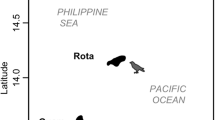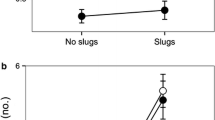Abstract
Invasive species generally occur and thrive in human-disturbed ecosystems, but Brachyponera chinensis (Asian needle ant, formerly ‘Pachycondyla chinensis’) also invades intact forests. The invasion into native habitats potentially puts B. chinensis in direct competition with the keystone seed-dispersing ants in the genus Aphaenogaster. We observed B. chinensis colonizing artificial nests placed in deciduous forest of the north Georgia Piedmont (US). Their presence appeared to displace existing Aphaenogaster rudis and Reticulitermes flavipes (subterranean termite) colonies. We subsequently mapped the B. chinensis invasion as well as co-existing A. rudis and R. flavipes colonies by examining coarse woody material (CWM) for nesting colonies. We tested whether the B. chinensis invasion changed with forest microclimates, covaried with A. rudis and/or R. flavipes occurrence, and whether it was associated with failed dispersal of a dominant understory herb. Our results and observations suggest that B. chinensis shares ecological niche requirements (temperature, moisture and CWM as nesting habitat) with A. rudis, severely diminishing the abundance of this native ant. In supplanting A. rudis, B. chinensis appears to play an equivalent role to A. rudis as a termite predator, but fails as a seed disperser. Essentially, the invader substitutes for the negative but not the positive species interactions, thereby apparently shifting ecological dynamics in the invaded system.




Similar content being viewed by others
References
Abe T (1990) Evolution of worker caste in termites. In: Veeresh GK, Mallik B, Viraktamath CA (eds) Social insects and the environment. Oxford and IBH, New Delhi
Akaike H (1973) Information theory as an extension of the maximum likelihood principle. In: Petrov BN, Csaki F (eds) Second international symposium on information theory. Akademiai Kiado, Budapest, pp 267–281
Bednar DM (2010) Pachycondyla (=Brachyponera) predation on Reticulitermes virginicus and competition with Aphaenogaster rudis. M.S. Thesis, North Carolina State. http://www.lib.ncsu.edu/resolver/1840.16/6363
Bednar DM, Silverman J (2011) Use of termites, Reticulitermes virginicus, as a springboard in the invasive success of a predatory ant, Pachycondyla (=Brachyponera) chinensis. Insectes Soc 58:459–467
Bednar DM, Shik JZ, Silverman J (2013) Prey handling perfomance facilitates competitive dominance of an invasive over native keystone ant. Behav Ecol 24:1312–1319
Bolton B (2010) Identification guide to the ant genera of the world. Harvard University Press, Cambridge
Bradford MA, Warren RJ II, Baldrain P et al (2014) Climate fails to predict wood decomposition at regional scales. Nat Clim Change 4:625–630
Buczkowski G, Bennett G (2007) Protein marking reveals predation on termites by the woodland ant, Aphaenogaster rudis. Insectes Soc 54:219–224
Buczkowski G, Bennett G (2008) Behavioral interactions between Aphaenogaster rudis (Hymenoptera: Formicidae) and Reticulitermes flavipes (Isoptera: Rhinotermitidae): the importance of physical barriers. J Insect Behav 21:296–305
Chase JM, Leibold MA (2003) Ecological niches: linking classical and contemporary approaches. University of Chicago, Chicago
Creighton WS (1950) The ants of North America. The Cosmos Press Inc., Cambridge
Darwin C (1859) The origin of species by means of natural selection or the preservation of favoured races in the struggle for life. Murray, London
Elton CS (1958) the ecology of invasions of animals and plants. Methuen, London
Emerson AE (1936) Termite distribution in the United States. Science 83:410–411
Felker-Quinn E, Schweitzer JA, Bailey JK (2013) Meta-analysis reveals evolution in invasive plant species but little support for Evolution of Increased Competitive Ability (EICA). Ecol Evol 3:739–751
Giladi I (2004) The role of habitat-specific demography, habitat-specific dispersal, and the evolution of dispersal distances in determining current and future distributions of the ant-dispersed forest herb, Hexastylis arifolia. University of Georgia, Athens, Georgia. http://coweeta.uga.edu/publications/2004_giladi_uga.pdf, pp. 175
Gotoh A, Ito F (2008) Seasonal cycle of colony structure in the Ponerine ant Pachycondyla chinensis in western Japan (Hymenoptera, Formicidae). Insectes Soc 55:98–104
Guenard B, Dunn RR (2010) A new (old), invasive ant in the hardwood forests of eastern North America and its potentially widespread impacts. PLoS One 5:e11614. doi:10.1371/journal.pone.0011614
Guenard B, Silverman J (2011) Tandem carrying, a new foraging strategy in ants: description, function, and adaptive significance relative to other described foraging strategies. Naturwissenschaften 98:651–659
Gurevitch J, Padilla DK (2004) Are invasive species a major cause of extinctions? Trends Ecol Evol 19:470–474
Hurlbert SH, Lombardi CM (2009) Final collapse of the Newman-Pearson decision theoretic framework and the rise of the neoFisherian. Ann Zool Fenn 46:311–349
Kahle D, Wickham H (2013) ggmap: a package for spatial visualization with Google Maps and OpenStreetMap. http://CRAN.R-project.org/package=ggmap
King JR, Tschinkel WR (2008) Experimental evidance that human impacts drive fire ant invasions and ecological change. Proc Natl Acad Sci 105:20339–20343
King JR, Tschinkel WR (2013) Experimental evidence for weak effects of fire ants in a naturally invaded pine-savanna ecosystem. Ecol Entomol 38:68–75
King JR, Warren RJ II, Bradford MA (2013) Social insects dominate eastern US temperate hardwood forest macroinvertebrate communities in warmer regions. PLoS One 8:e75843
Korb J (2007) Termites. Curr Biol 17:995–999
Lessard JP, Fordyce JA, Gotelli NJ et al (2009) Invasive ants alter the phylogenetic structure of ant communities. Ecology 90:2664–2669
Liu H, Stiling P (2006) Testing the enemy release hypothesis: a review and meta-analysis. Biol Invasions 8:1535–1545
Lubertazzi D (2012) The biology and natural history of Aphaenogaster rudis. Psyche 2012:1–11
Martin PH, Canham CD, Marks PL (2009) Why forests appear resistant to exotic plant invasions: intentional introductions, stand dynamics, and the role of shade tolerance. Front Ecol Environ 7:142–149
Matsuura K (2002) Colony-level stabilization of soldier head width for head-plug defense in the termite Reticulitermes speratus (Isoptera: Rhinotermitidae). Behav Ecol Sociobiol 51:172–179
Menke SB, Holway DA (2006) Abiotic factors control invasion by Argentine ants at the community scale. J Anim Ecol 75:368–376
Nelder MP, Paysen ES, Zungoli PA et al (2006) Emergence of the introduced ant Pachycondyla chinensis (Formicidae: Ponerinae) as a public health threat in the southeastern United States. J Med Entomol 43:1094–1098
Ness JH, Morin DF, Giladi I (2009) Uncommon specialization in a mutualism between a temperate herbaceous plant guild and an ant: are Aphaenogaster ants keystone mutualists? Oikos 12:1793–1804
Ordonez A, Wright IJ, Olff H (2010) Functional differences between native and alien species: a global-scale comparison. Funct Ecol 24:1353–1361
Pudlo RJ, Beattie AJ, Culver DC (1980) Population consequences of changes in ant-seed mutualism in Sanguinaria canadensis. Oecologia 146:32–37
Rice ES, Silverman J (2013) Propagule pressure and climate contribute to the displacement of Linepithema humile by Pachycondyla chinensis. PLoS One 8:856281
Rodriguez-Cabal MA, Stuble KL, Guenard B et al (2012) Disruption of ant-seed dispersal mutualisms by the invasive Asian needle ant (Pachycondyla chinensis). Biol Invasions 14:557–565
Roura-Pascual N, Bas JM, Hui C (2010) The spread of the Argentine ant: environmental determinants and impacts on native ant communities. Biol Invasions 12:2399–2412
Sanders NJ, Saurez AV (2011) Elton’s insights into the ecology of ant invasions: lessons learned and lessons still to be learned. In: Richardson DM (ed) Fifty Years of Invasion Ecology. Blackwell Publishing, Hoboken
Smallwood J (1982) Nest relocation in ants. Insectes Soc 29:138–147
Smith MR (1934) Ponerine ants of the genus Euponera in the United States. Ann Entomol Soc Am 27:558–564
Smith DR (1979) Catalog of Hymenoptera in America North of Mexico. Smithsonian Institution Press, Washington, DC
Talbot M (1951) Populations and hibernating conditions of the ant Aphaenogaster (Attomyrma) rudis Emery (Hymenoptera: Formicidae). Ann Entomol Soc Am 44:302–307
Thorne BL, Traniello JFA, Adams ES et al (1999) Reproductive dynamics and colony structure of subterranean termites of the genus Reticulitermes (Isoptera: Rhinotermitidae): a review of the evidence from behavioral, ecological, and genetic studies. Ethol Ecol Evol 11:149–169
Umphrey GJ (1996) Morphometric discrimination among sibling species in the fulva - rudis - texana complex of the ant genus Aphaenogaster (Hymenoptera: Formicidae). Can J Zool 74:528–559
Vargo EL, Leniaud I, Swoboda LE et al (2013) Clinal variation in colony breeding structure and level of inbreeding in the subterranean termites Reticulitermes flavipes and R. grassei. Mol Ecol 22:1447–1462
Vila M, Espinar JL, Hejda M et al (2011) Ecological impacts of invasive alien plants: a meta-analysis of their effects on species, communities and ecosystems. Ecol Lett 14:702–708
Warren RJ II, Bradford MA (2011) The shape of things to come: woodland herb niche contraction begins during recruitment in mesic forest microhabitat. Proc R Soc B Biol. Sci. 278:1390–1398
Warren RJ II, Bradford MA (2012) Ant colonization and coarse woody debris decomposition in temperate forests. Insectes Soc 59:215–221
Warren RJ II, Bradford MA (2013) Mutualism fails when climate response differs between interacting species. Glob Change Biol 20:466–474
Warren RJ II, Giladi I (2014) Ant-mediated seed dispersal: a few ant species (Hymenoptera: Formicidae) benefit many plants. Myrmecol News 20:129–140
Warren RJ II (2007) Linking understory evergreen herbaceous distributions and niche differentiation using habitat-specific demography and experimental common gardens. University of Georgia, Athens, GA. http://coweeta.uga.edu/publications/10315.pdf
Warren RJ II, Giladi I, Bradford MA (2010) Ant-mediated seed dispersal does not facilitate niche expansion. J Ecol 98:1178–1185
Warren RJ II, Giladi I, Bradford MA (2014) Competition as a mechanism structuring mutualisms. J Ecol 102:486–495
Yashiro T, Matsuura K, Guenard B et al (2010) On the evolution of the species complex Pachycondyla chinensis (Hymenoptera: Formicidae: Ponerinae), including the origin of its invasive form and description of a new species. Zootaxa 2685:39–50
Zalasiewicz J, Williams M, Smith A et al (2008) Are we now living in the Anthropocene? GSA Today 18:4–8
Zelikova TJ, Sanders D, Dunn RR (2011) The mixed effects of experimental ant removal on seedling distribution, belowground invertebrates, and soil nutrients. Ecosphere 2:1–14
Zungoli PA, Benson EP (2008) Seasonal occurrence of swarming activity and worker abundance of Pachycondyla chinensis (Hymenoptera: Formicidae). In: Robinson WH, Bajomi D (eds) Proceedings of the Sixth International Conference on Urban Pests. OOK-Press Kft, Veszprem
Acknowledgments
We thank Holly Emmert, Lauren Evans, Katie Mackoul, Mallory Nickel, Chris Dodge, Charlene Gray and Sara Miller from the Highlands Biological Station Climate Change Ecology course for field assistance. We also thank Phil Lester for helpful manuscript comments. This is the Termite Ecology and Myrmecology (TEAM) working group publication number 4.
Author information
Authors and Affiliations
Corresponding author
Rights and permissions
About this article
Cite this article
Warren, R.J., McMillan, A., King, J.R. et al. Forest invader replaces predation but not dispersal services by a keystone species. Biol Invasions 17, 3153–3162 (2015). https://doi.org/10.1007/s10530-015-0942-z
Received:
Accepted:
Published:
Issue Date:
DOI: https://doi.org/10.1007/s10530-015-0942-z




